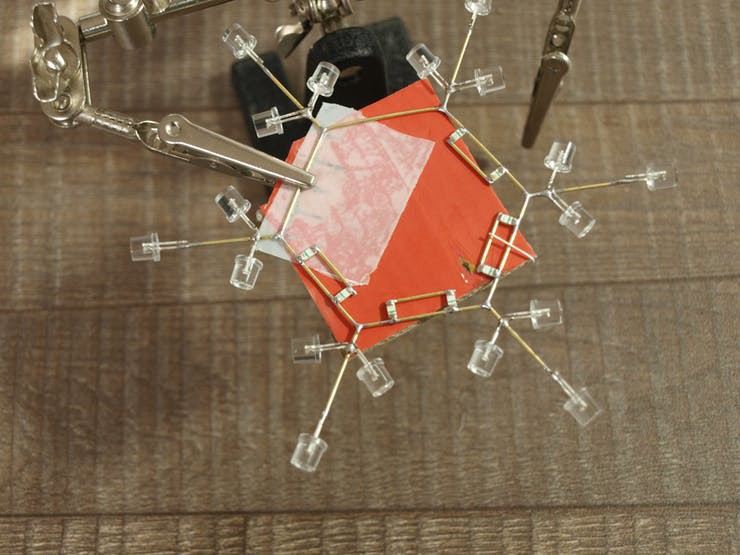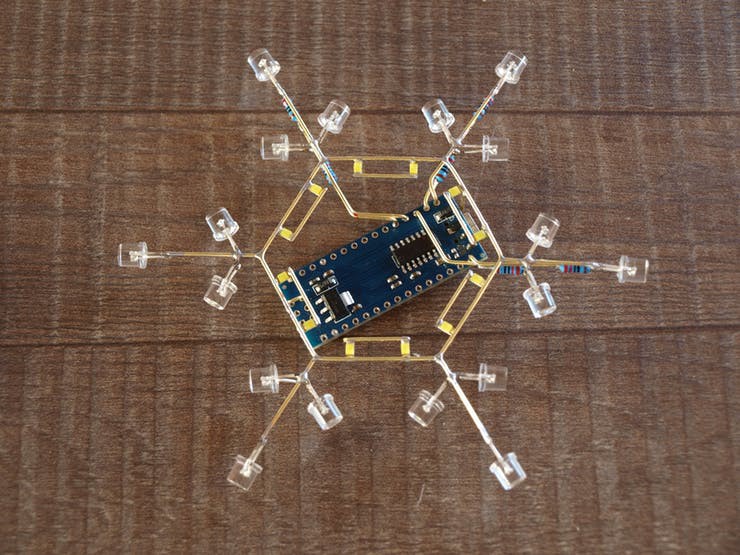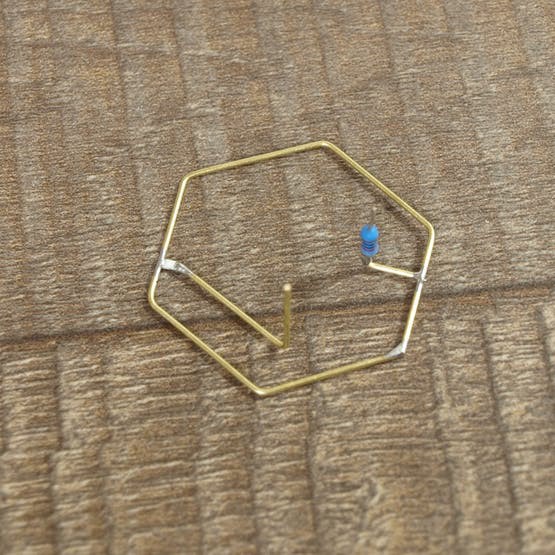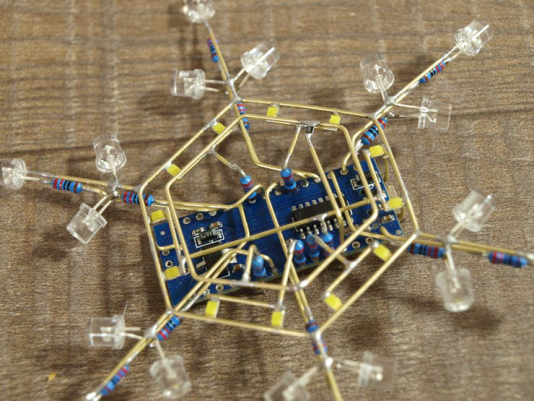-
1Construct a Core Hexagon
First, I constructed a core hexagon by bending a brass rod and welding the ends together. By adding another 6 brass rods protruding from the top of the hexagon, the ground wire is completed, and now it is necessary to solder all the cathode leads of the LED to it to create a snowflake pattern. The tricky part is to add SMD LEDs, we might as well use fixtures made of cardboard and double-sided tape.
![]()
-
2Add the Arduino Nano under the Core Structure
Next is to add the Arduino Nano under the core structure, leaving enough space in between to satisfy the 3-layer brass rod wiring, which will connect the microcontroller pins to all LED anode leads. This also requires great patience. Not only do you need to avoid short circuits between wires, but also add current limiting resistors and make them look good.
![]()
The blade LEDs are connected to the nearest Arduino output pins, respectively. The branch LEDs are grouped in two and connected to the PWM pins. The core LEDs are also grouped in two and connected to the remaining pins. The Arduino NANO only has 18 output pins. I need one pin for the touch sensor, which leaves only 17 pins, so the two pairs of core LEDs are connected together to form a group of 4. I use a 220Ω resistor to limit the current flowing through each pin to about 8mA. This means a total of 240mA, which is a bit high for the ATmega328 chip, but it works. The safe maximum is said to be 200mA.
-
3Add Another Brass Rod
To be able to interact with snowflakes, I added another brass rod to make a capacitive touch sensor.
![]()
-
4Remeber to Check All Diodes Before Soldering
Don't forget to check all diodes at any time before soldering. It will be difficult to replace it if there is an open circuit or reverse polarity connection.
-
5Source Code
#include "SoftPWM.h"
#include <ADCTouchSensor.h>
byte edgeLedPins[] = {13, A4, A5, 2, 8, 12};
byte middleLedPins[] = {10, 6, 3, 5, 9, 11};
byte innerLedPins[] = {A2, A3, A1, 4, 7, A1};
ADCTouchSensor touchSensor = ADCTouchSensor(A0, 1);
void setup() {
Serial.begin(115200);
SoftPWMBegin();
}
byte animation = 0;
long touchAt = 0;
void loop() {
switch (animation) {
case 0:
_fill(100);
break;
case 1:
shinyAnimation();
//fadingAnimation();
break;
case 2:
circleAnimation();
break;
case 3:
loopAnimation();
break;
case 4:
fireworkAnimation();
fireworkAnimation();
fireworkAnimation();
fireworkAnimation();
fireworkAnimation();
fireworkAnimation();
animation ++;
break;
case 5:
smileAnimation();
break;
default:
animation = 0;
break;
}
int touchValue = touchSensor.read();
if (touchAt + 2000 < millis() && touchValue > 1000) {
touchAt = millis(); // touch down, cold down timeout is 2s
animation ++;
_fill(0);
}
}
void fireworkAnimation() {
for (int i = 0; i < 4; i++) {
SoftPWMSet(innerLedPins[i], 100);
delay(100);
}
SoftPWMSet(innerLedPins[4], 100);
for (int i = 0; i < 6; i++) {
SoftPWMSet(middleLedPins[i], 255);
}
delay(50);
for (int i = 0; i < 6; i++) {
SoftPWMSet(innerLedPins[i], 0);
SoftPWMSet(edgeLedPins[i], 255);
}
delay(50);
for (int i = 0; i < 6; i++) {
SoftPWMSet(middleLedPins[i], 0);
}
delay(50);
_fill(0);
}
void smileAnimation() {
SoftPWMSet(innerLedPins[1], 100);
SoftPWMSet(innerLedPins[3], 100);
SoftPWMSet(middleLedPins[0], 255);
SoftPWMSet(middleLedPins[5], 255);
SoftPWMSet(edgeLedPins[2], 255);
SoftPWMSet(edgeLedPins[3], 255);
delay(2000);
SoftPWMSet(innerLedPins[1], 0);
SoftPWMSet(innerLedPins[3], 0);
delay(100);
SoftPWMSet(innerLedPins[1], 100);
SoftPWMSet(innerLedPins[3], 100);
delay(100);
SoftPWMSet(innerLedPins[1], 0);
SoftPWMSet(innerLedPins[3], 0);
delay(100);
}
byte circleState[] = {100, 55, 10};
byte circleStateAnimation[] = {1, 1, 1};
void circleAnimation() {
for (int i = 0; i < 3; i++) {
if (circleState[i] >= 100) {
circleStateAnimation[i] = -1; // dim
}
else if (circleState[i] <= 10) {
circleStateAnimation[i] = 1; // bright
}
circleState[i] += circleStateAnimation[i];
}
for (int i = 0; i < 6; i++) {
SoftPWMSet(innerLedPins[i], circleState[0]);
SoftPWMSet(middleLedPins[i], circleState[1]);
SoftPWMSet(edgeLedPins[i], circleState[2]);
}
delay(5);
}
byte waveState[] = {100, 55, 10, 10, 55, 100};
byte waveStateAnimation[] = {1, 1, 1, -1, -1, -1};
void waveAnimation() {
for (int i = 0; i < 6; i++) {
if (waveState[i] >= 100) {
waveStateAnimation[i] = -1; // dim
}
else if (waveState[i] <= 10) {
waveStateAnimation[i] = 1; // bright
}
waveState[i] += waveStateAnimation[i];
}
for (int i = 0; i < 6; i+=2) {
SoftPWMSet(innerLedPins[i], waveState[0]);
SoftPWMSet(middleLedPins[i], waveState[1]);
SoftPWMSet(edgeLedPins[i], waveState[2]);
SoftPWMSet(innerLedPins[i + 1], waveState[3]);
SoftPWMSet(middleLedPins[i + 1], waveState[4]);
SoftPWMSet(edgeLedPins[i + 1], waveState[5]);
}
delay(10);
}
byte loopCounter = 0;
byte loopState = 150;
void loopAnimation() {
SoftPWMSet(innerLedPins[loopCounter], loopState);
SoftPWMSet(middleLedPins[loopCounter], loopState);
SoftPWMSet(edgeLedPins[loopCounter], loopState);
loopCounter = _nextIndex(loopCounter, 1);
if (loopCounter == 0) {
loopState = (loopState == 150 ? 0 : 150);
}
delay(100);
}
byte slowOnCounter = 0;
byte slowOnState = 150;
void slowOnAnimation() {
byte randomLed = random(0, 18);
if (randomLed < 6) {
SoftPWMSet(innerLedPins[randomLed], slowOnState);
}
else if (randomLed < 12) {
SoftPWMSet(middleLedPins[randomLed - 6], slowOnState);
}
else {
SoftPWMSet(edgeLedPins[randomLed - 12], slowOnState);
}
slowOnCounter ++;
if (slowOnCounter >= 50) {
slowOnCounter = 0;
slowOnState = (slowOnState == 150 ? 0 : 150);
}
delay(50);
}
byte shinyState[] = {0, 100, 0, 100, 0, 100};
byte shinyStateAnimation[] = {1, 1, 1, 1, 1, 1};
byte shinyCounter = 0;
void shinyAnimation() {
for (int i = 0; i < 6; i++) {
if (shinyState[i] >= 100) {
shinyStateAnimation[i] = -1; // dim
}
else if (shinyState[i] <= 0) {
shinyStateAnimation[i] = 1; // bright
}
shinyState[i] += shinyStateAnimation[i];
SoftPWMSet(edgeLedPins[i], shinyState[i]);
}
shinyCounter ++;
if (shinyCounter > 10) {
shinyCounter = 0;
for (byte r = random(1, 3); r > 0; r--) {
byte randomLed = random(0, 12);
if (randomLed < 6) {
SoftPWMSet(innerLedPins[random(0, 6)], 255);
}
else {
SoftPWMSet(middleLedPins[random(0, 6)], 255);
}
}
}
else {
for (int i = 0; i < 6; i++) {
SoftPWMSet(innerLedPins[i], 20);
SoftPWMSet(middleLedPins[i], 20);
}
}
delay(30);
}
byte fadingState[] = {0, 100, 0, 100, 0, 100};
byte fadingStateAnimation[] = {1, 1, 1, 1, 1, 1};
void fadingAnimation() {
for (int i = 0; i < 6; i++) {
if (fadingState[i] >= 100) {
fadingStateAnimation[i] = -1; // dim
}
else if (fadingState[i] <= 0) {
fadingStateAnimation[i] = 1; // bright
}
fadingState[i] += fadingStateAnimation[i];
SoftPWMSet(edgeLedPins[i], fadingState[i]);
SoftPWMSet(middleLedPins[_nextIndex(i, 1)], fadingState[i]);
SoftPWMSet(innerLedPins[i], 50);
}
delay(20);
}
void _fill(byte value) {
for (int i = 0; i < 6; i++) {
SoftPWMSet(edgeLedPins[i], value);
SoftPWMSet(middleLedPins[i], value);
SoftPWMSet(innerLedPins[i], value);
}
}
byte _prevIndex(short index, byte step) {
index -= step;
while (index < 0) {
index += 6;
}
return index;
}
byte _nextIndex(short index, byte step) {
index += step;
while (index > 5) {
index -= 6;
}
return index;
}
Arduino Amazing Interactive Snowflake
To make an amazing interactive snowflake with Arduino Nano.
 Deion
Deion



Discussions
Become a Hackaday.io Member
Create an account to leave a comment. Already have an account? Log In.